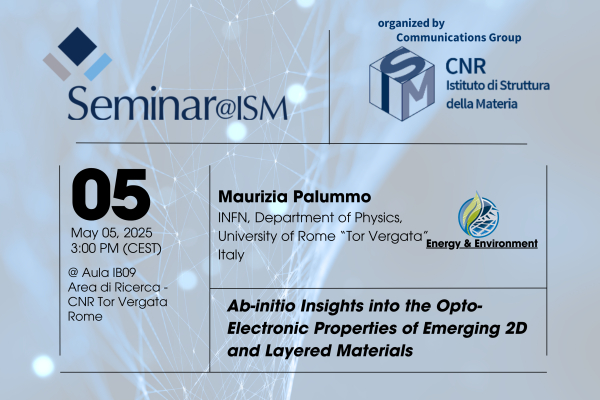The development of next-generation opto-electronic technologies relies on the discovery and understanding of novel low-dimensional materials. In this context, first-principles (ab-initio) simulations play a crucial role in unveiling the microscopic mechanisms that govern their properties, and in guiding experimental efforts through reliable predictions.
In this talk, I will present results obtained over the last years through parameter-free atomistic simulations aimed at exploring and tuning the opto-electronic properties of emerging 2D and layered materials. Using Density Functional Theory (DFT) and Many-Body Perturbation Theory (MBPT) approaches, such as GW and the Bethe-Salpeter Equation (BSE), we investigate: (i) electronic band gap renormalization, (ii) strong light- matter interaction, (iii) excitonic effects and radiative lifetimes, and (iv) the role of doping and chemical substitution as tuning mechanisms.
Particular attention will be devoted to materials families of interest for opto-electronic applications, including Transition Metal Dichalcogenides (TMDs) and 2D/layered halide perovskites. I will also discuss the excitonic properties of the MoSi₂N₄ family and carbon-based 2D triangulene polymers, highlighting their potential in emerging technologies.
Maurizia Palummo is a Full professor at the Physics Department of the University of Rome “Tor Vergata”. After working as a post-doc and researcher at the Physics Department of the University of Rome “Tor Vergata”, at INFM, and at the ENEA Casaccia research center, in 2017 she became an associate professor at the Physics Department of the University of Rome “Tor Vergata”.
Following an initial period of experimental work in Condensed Matter Physics on the optical properties of defects and color centers in isolant matrices, she worked for many years in the field of first-principles calculations of the structural, electronic, and optical properties of materials, including semiconducting and metal surfaces, clean or covered with atomic and molecular adsorbates. In the last years two dimensional materials, organic compounds and materials for energy applications like perovskites, is the main of her research activity. She has expertise in the most modern theories and computational tools of first-principles electronic structure calculations (Car Parrinello, GW method, BSE exciton calculation, parallelization). She is a member of the developers/superusers team of the many-body code yambo (www.yambo-code.org). She organized several conferences and is author of more than 140 publications, most of them in relevant international peer-reviewed journals, such as Nature Physics, Nature Nanotechnology, Nature Communications, Nano Letters, Advanced Functional Materials, etc. She has been Principal Investigator of several national and international projects, in particular on High Performance Computing. She was selected in the World’s top 2% scientists Stanford University 2023.


 English (UK)
English (UK)  Italiano (Italia)
Italiano (Italia)